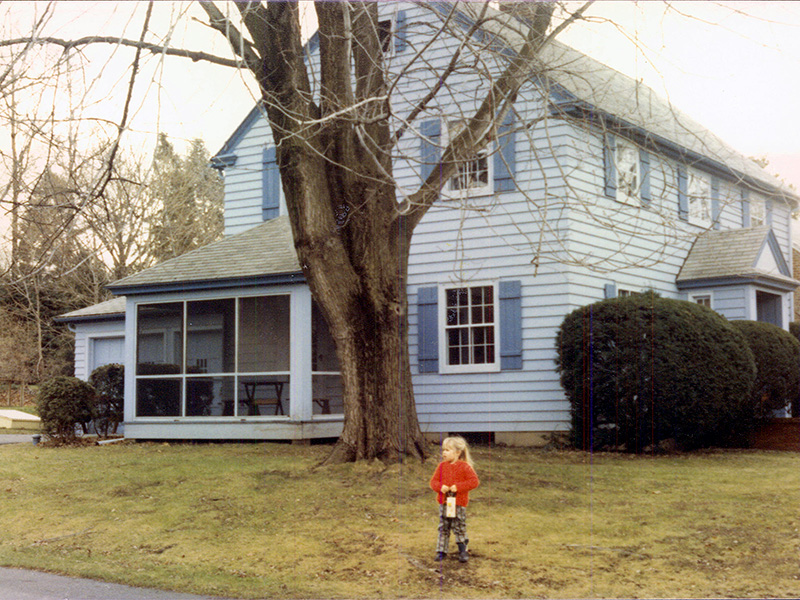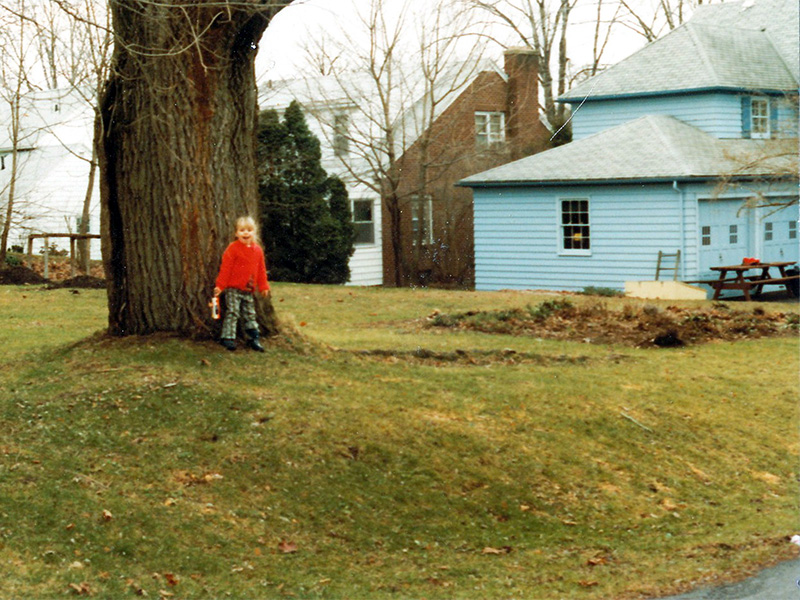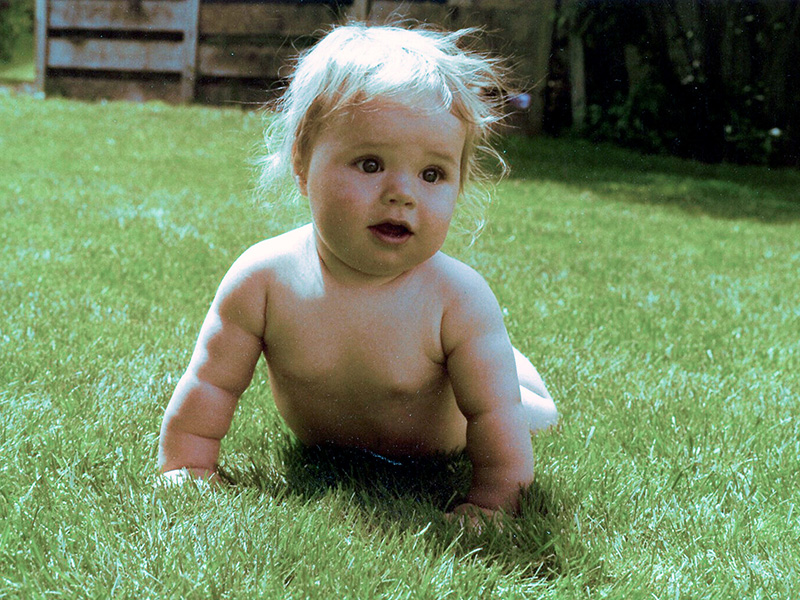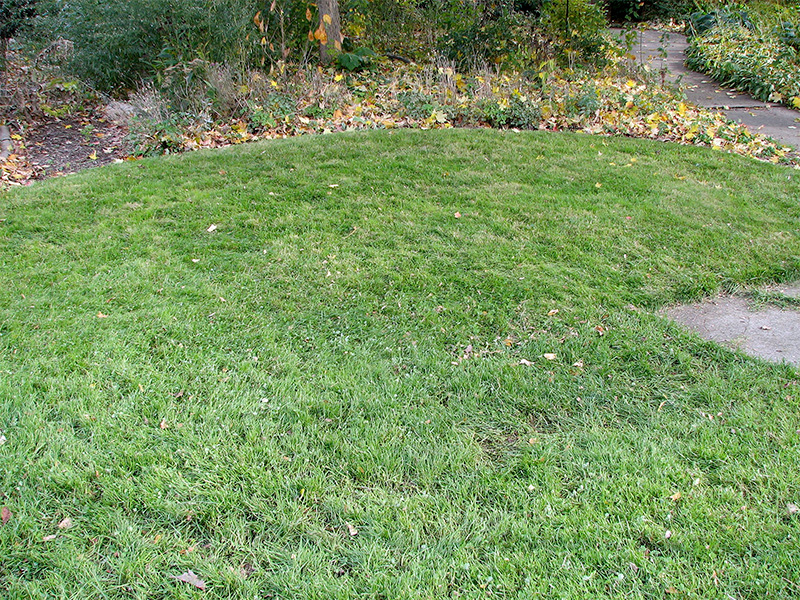Why are Americans so wed to their lawns?
At our first house and for the first fifteen years or so that we lived at our current house, we still had a lot of lawn — although at least we soon used some of our land for a vegetable garden and some flower borders.

Our original front yard

Our original side yard with a silver maple.

Our original back yard with a weeping willow.
When I think back at our previous lawn practices, I’m horrified! What seems so obviously bad now just seemed like normal yard care back then — just a way of being a responsible citizen.

For a few years, we even had a lawn service so we, too, could have a perfect lawn, the hallmark of suburban life.
Especially horrifying is that we allowed our young daughter to be on the treated lawn!
We finally realized we could have a less environmentally damaging lawn if we were willing to accept a “good enough” lawn. To us this means “it’s green and we can walk on it.” We also greatly reduced the size of our lawns, leaving space for more useful vegetation.

Ironically, once we stopped treating it and just left grass clippings on the lawn, our lawn has done just fine and is comparable to others in the neighborhood, and even better than some.
Here are some ways we’ve changed our lawn practices over the years — and why:
- The problems with lawns
- Reducing the amount of our lawn
- Taking care of our lawn organically
- Planting alternatives to conventional turfgrass
We especially appreciate the sentiments in this funny lawn story and especially in this poem.
Resources
- Redesigning the American Lawn by F. Herbert Bormann et. al. is a wonderful book with excellent diagrams showing, for example, the CO2 the lawn creates/absorbs. It offers the concept of a Freedom Lawn. This is from Yale’s School of Environmental Science and is based on sound science.
- Homegrown National Park:
- VIDEO: How do I convert my lawn to natives (even if I’m not a gardener) – Doug Tallamy
- Choose Natives:
- New York Times:
- They fought the lawn. And the lawn’s done
- Corporate landscaping lets its hair down
- Why mow? The case against lawns – by Michael Pollan, 1989
- Washington Post:
- WBUR:
- The Guardian:
- Pollinator Pathway:
- No Mow May is over; now what? Reducing lawn area is best, but until then, mow less!
- CNN:
- Why the Great American Lawn is terrible for the West’s water crisis – Why waste the world’s water on something that doesn’t support life?
- Community-based Social Marketing:
- Suburban Lawns: Dimensions of Meaning, Activities, and Environmental Concerns – Here’s an excerpt from this study’s conclusions: … contemporary American values, attitudes, and practices regarding the lawn are deeply rooted in historical antecedents and unquestioned by homeowners. Very few family activities were reported occurring on the lawn. The primary activity related to the lawn was maintenance. Respondents value their lawns for aesthetic, psychological, normative, and economic reasons. A lawn is considered a source of beauty, pleasure, and economic value; an integral part of one’s home, sending a clear message to others about the kind of people who live in the house. Respondents consider the use of lawn chemicals to be necessary to maintain an ideal lawn.
Reflections
I always encourage my clients to practice intentional “lawn-i-cide,” so they can conserve water, increase the habitat value of their garden, eliminate the use of gas-powered and polluting mowers, and escape the paralyzing boredom of an uninterrupted swath of green. Time to ignore the siren song of the “perfect lawn.”
~ Billy Goodnick, Landscape architect
Let a man drink or default, cheat on his taxes or cheat on his wife, and the community will find forgiveness in their heart. But let him fail to keep his front lawn mowed, and those hearts will turn to stone.
~ William Zinsser
Nearly everything about how Americans “care” for their lawns is deadly. Pesticides prevent wildflower seeds from germinating and poison the insects that feed songbirds and other wildlife. Lawn mower blades, set too low, chop into bits the snakes and turtles and baby rabbits that can’t get away in time. Mulch, piled too deep, smothers ground-nesting bees, and often the very plants that mulch is supposed to protect, as well.
~ Margaret Renkl, New York Times
A lawn is nature under culture’s boot.
~ Michael Pollan, Second Nature
Life — in all its variability, changeability, and potential to surprise and delight — is beautiful. And life is what our lawns are missing. Biologically speaking, our lawns are nearly dead.
~ Evelyn Haddon, LessLawn.com
In one weekend, we spent $60 million on [the movie] “Signs.” But in one year we spend $25 billion on 20 million acres of a crop that we can’t eat, wear or sell. We use 32 million pounds of pesticides, 580 million gallons of gasoline, and more water than we shower on ourselves in order to color and keep the grass green.…My movie? It would be about the struggle with an alien species that forced humans into slavery while it took over 20 million acres of land.
~ Ellen Goodman, Obsession with a perfect lawn should be mowed down
What we forget today is that while labor-saving devices are not all bad, neither is labor …
~ Doris Longacre, Living More with Less
